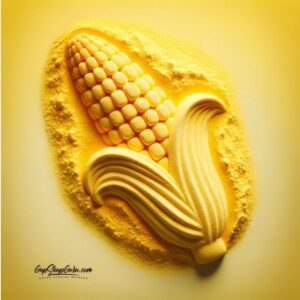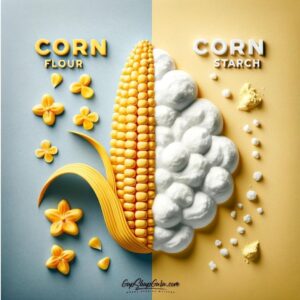Corn flour and corn starch are staple ingredients found in kitchens and industries worldwide. These powders are derived from corn and play crucial roles in cooking, baking, and even non-food applications. Despite their common source, corn flour and corn starch have different purposes and distinct properties.
This article explores these versatile products in detail, focusing on their definitions, differences, production methods, health benefits, and names in Hindi and English. Designed for Indian readers, we present this information in simple English to make it accessible to everyone interested in deepening their understanding of corn-based products. Related: The Thirsty Crow Full Story In English
What is Corn Flour?
Corn flour is a fine powder made by grinding whole corn kernels. It retains the corn’s hull and germ, giving it a yellow colour and a rich, nutty flavour. In the culinary world, corn flour is used to thicken soups and sauces, as a breading for fried foods, and as a base for cornbread and other baked goods. Beyond cooking, it finds applications in the manufacturing of bioplastics and as a filler in some pharmaceutical products.

In Hindi, corn flour is known as “मकई का आटा” (Makai ka aata), reflecting its all-purpose use in traditional and contemporary Indian cuisine. Its versatility makes it a valuable ingredient in both savoury and sweet dishes, adding a distinct texture and flavour.
What is Corn Starch?
On the other hand, corn starch is a white, chalky powder made from the endosperm of the corn kernel. Through a process of milling and separating the starch from the protein and fibre, manufacturers produce a refined product that acts as a powerful thickening agent. Corn starch is commonly used to create a glossy finish in sauces and gravies and as a key ingredient in custards, puddings, and confectioneries.

Known in Hindi as “मकई का स्टार्च” (Makai ka starch), corn starch holds a significant place in both Indian and international cuisines. Its ability to thicken without altering the flavour of dishes makes it an indispensable tool for chefs and home cooks alike.
What is the Difference Between Corn Flour and CornStarch?
Understanding the differences between Corn Flour and cornstarch is crucial for their effective use in cooking and baking. Here are the key points that distinguish these two products:

Composition and Texture of Corn Flour VS CornStarch
- Corn Flour: Made from the whole kernel, corn flour contains protein, fibre, and starch, giving it a slightly grainy texture and a yellowish colour.
- Corn Starch: Extracted solely from the starchy part of the corn, it is refined and lacks fibre and protein, resulting in a fine, white powder.
Culinary Uses of Corn Flour VS CornStarch
- Corn Flour: It’s used as flour in baking, for breading, and as a thickener that contributes to the dish’s flavour and colour.
- Corn Starch: Primarily used as a thickening agent in sauces, soups, and desserts, it’s favoured for its neutral taste and clear, glossy appearance after cooking.
Impact on Cooking of Corn Flour VS CornStarch
- Corn Flour: Adds a corn flavour to dishes and tends to make baked goods more dense and hearty.
- Corn Starch: Acts as a binder and thickener, creating a smooth texture without altering the flavour of the food.
Understanding these differences is key to utilising each product effectively in your culinary endeavours, ensuring the desired outcome in the texture, taste, and appearance of your dishes.
How to Make Cornflour vs Cornstarch at Home
Cornflour vs Cornstarch – Making corn flour and corn starch at home is a straightforward process that can be rewarding, especially for those looking to control their food’s ingredients or reduce waste. Here’s how you can make each:
Making Corn Flour at Home
- Select and Clean: Start with fresh, organic corn kernels. Clean them thoroughly to remove any dirt or impurities.
- Dry the Kernels: Spread the cleaned kernels on a baking sheet and allow them to dry completely, either under the sun or in a low oven.
- Grind the Kernels: Once dry, use a grain mill or a high-power blender to grind the kernels into a fine powder. For a finer consistency, sift the flour to remove any large particles.
- Storage: Store the corn flour in an airtight container in a cool, dry place. It can also be refrigerated to extend its shelf life.
Making Corn Starch at Home
- Rinse and Soak: Begin with corn kernels. Rinse them thoroughly, then soak them in water for about 24 hours, changing the water a couple of times.
- Blend and Strain: Drain the kernels and blend them with fresh water until you achieve a smooth consistency. Strain this mixture using a cheesecloth or a fine strainer to separate the liquid from the solid parts.
- Settle and Decant: Allow the liquid to settle for a few hours. The starch will settle at the bottom. Carefully decant the water from the top.
- Dry the Starch: Spread the wet starch on a baking sheet and allow it to dry completely, either in the sun or a low oven.
- Break and Store: Once dry, break the starch into a powdery consistency using a blender. Store it in an airtight container in a cool, dry place.
Making corn flour and corn starch at home not only provides a sense of accomplishment but also ensures you have pure, unadulterated products for your cooking and baking needs.
Health Benefits of Corn Flour & Corn Starch

Corn Flour Benefits
Corn flour, being made from the whole corn kernel, retains much of the nutritional value of corn. It is a good source of fibre, vitamins, and minerals, particularly:
- Fibre: Helps in maintaining digestive health, promoting regular bowel movements, and may aid in managing blood sugar levels.
- Vitamin B: Corn flour contains B vitamins, especially thiamine (B1) and niacin (B3), which are crucial for energy production and maintaining healthy brain function.
- Minerals: It is a source of essential minerals like magnesium, phosphorus, iron, and zinc, supporting bone health, immune function, and overall well-being.
Including corn flour in your diet can offer health benefits, particularly when used as part of a balanced and varied diet. Its high fibre content, for instance, can help manage weight by providing a feeling of fullness and reducing overall calorie intake.
Corn Starch Benefits
Corn starch is primarily a carbohydrate, and while it is more refined and contains less fibre and nutrients compared to corn flour, it still has its place in a healthy diet, particularly for specific dietary needs:
- Gluten-Free: For those with celiac disease or gluten sensitivity, corn starch is a valuable gluten-free thickening agent that can be used in cooking and baking.
- Energy Source: As a concentrated source of carbohydrates, corn starch can provide quick energy, making it useful in certain dietary contexts where rapid glucose availability is required.
It’s important to use corn starch in moderation within a balanced diet, considering its high caloric content and lower nutritional profile compared to less refined alternatives.
Nutritional Considerations
Both corn flour and corn starch can be part of a healthy diet when used judiciously. Corn flour, with its higher fibre and nutrient content, offers more health benefits and can be a healthier choice for regular use. While limited in nutrients, corn starch serves specific culinary and dietary roles that cannot be overlooked.
Incorporating these products into your diet provides versatility in cooking and baking, catering to various dietary needs and preferences. However, as with all foods, moderation and balance are key to maximising health benefits while minimising potential drawbacks.
FAQs
To conclude our exploration, here are some frequently asked questions about corn flour and corn starch:
Can I substitute corn flour for corn starch (and vice versa)?
While both are derived from corn, their different textures and cooking properties mean they are not always interchangeable. Corn starch is a more effective thickener, and using corn flour instead might result in a heavier or grittier texture. It’s best to use them as intended for thickening unless adjustments are made for specific recipes.
How should corn flour and corn starch be stored?
Both should be stored in airtight containers in a cool, dry place. If you live in a particularly humid climate, storing them in the refrigerator can help extend their shelf life.
Are there any health risks associated with corn flour or corn starch?
Both are safe for most people in moderation. However, those with a corn allergy should avoid them. Additionally, because corn starch is high in calories and carbs but low in nutrients, relying on it heavily could contribute to an imbalanced diet.
What is corn flour used for in cooking?
Corn flour is used for thickening soups, sauces, and gravies, as a base for gluten-free baking, and to add texture and flavour to bread, tortillas, and other baked goods.
Can I make corn flour at home?
Yes, you can make corn flour at home by drying corn kernels and grinding them into a fine powder using a high-powered blender or grain mill.
What’s the difference between corn flour and corn starch?
Corn flour is made from the whole kernel, offering flavour and nutrients, while corn starch is derived from the endosperm of the kernel. Due to its neutral taste, corn starch is used primarily as a thickening agent.
How do I substitute corn flour for wheat flour in recipes?
When substituting corn flour for wheat flour, use a 1:1 ratio, but be mindful that recipes may require adjustments in liquid content due to corn flour’s different absorption rates.
Is corn flour gluten-free?
Yes, corn flour is naturally gluten-free, making it a popular choice for those with gluten sensitivities or celiac disease and suitable for various gluten-free recipes.
Conclusion
Corn flour and corn starch, each with its own unique properties, applications, and health implications, are versatile ingredients in the culinary world. Understanding their differences, how to make them at home, and their health benefits enables informed choices in their use, contributing to a varied and balanced diet. Whether thickening a sauce with corn starch or baking with corn flour, these corn-derived products offer endless possibilities for enhancing our meals’ texture, flavour, and nutritional content.
This comprehensive guide aims to give readers a deep understanding of corn flour and corn starch, equipping them with the knowledge to utilise these ingredients effectively in their cooking practices and make choices that align with their dietary needs and preferences.

Comments are closed.